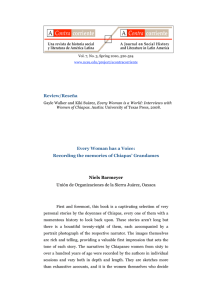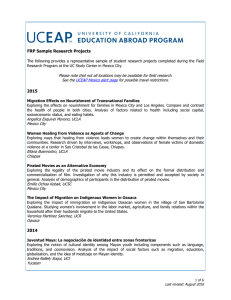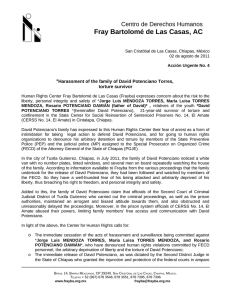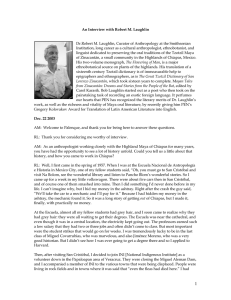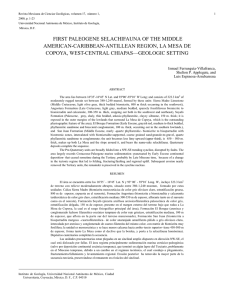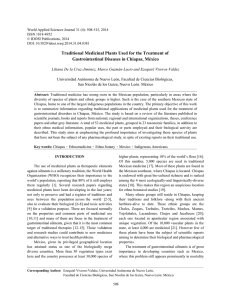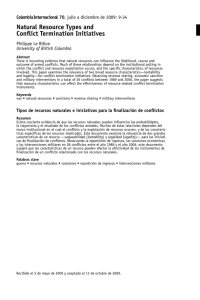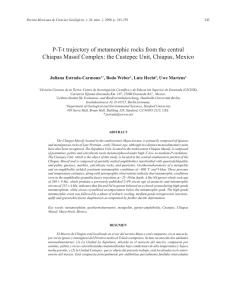The Curse of “Golden Gourd”: Conflicts in Chimalapas
Anuncio
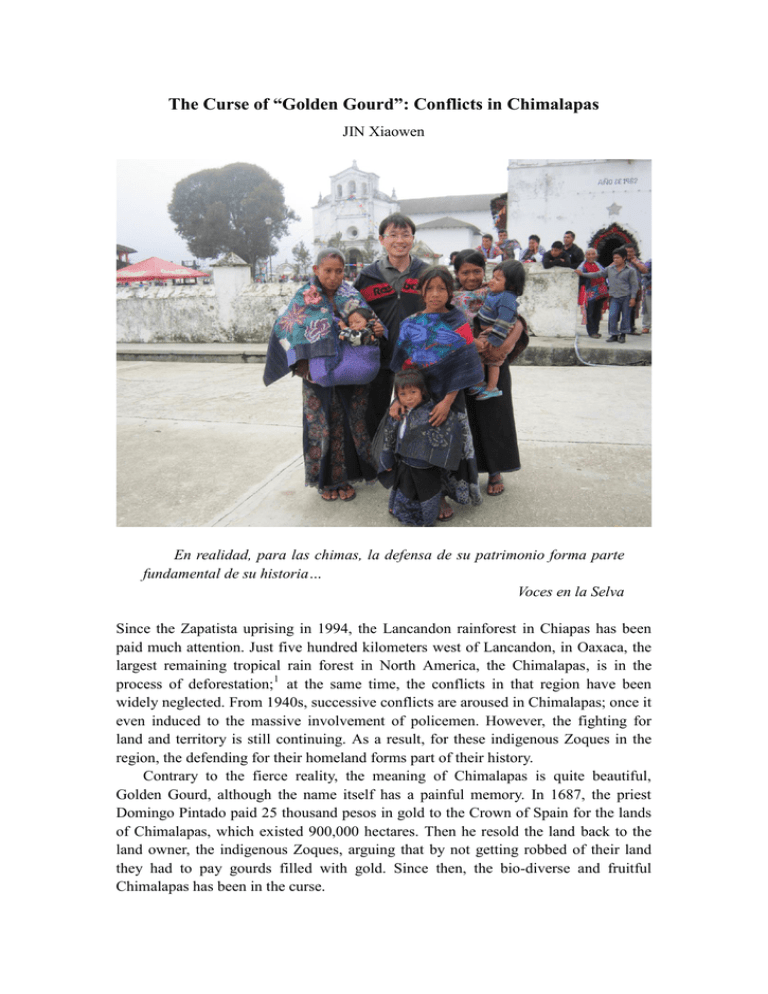
The Curse of “Golden Gourd”: Conflicts in Chimalapas JIN Xiaowen En realidad, para las chimas, la defensa de su patrimonio forma parte fundamental de su historia… Voces en la Selva Since the Zapatista uprising in 1994, the Lancandon rainforest in Chiapas has been paid much attention. Just five hundred kilometers west of Lancandon, in Oaxaca, the largest remaining tropical rain forest in North America, the Chimalapas, is in the process of deforestation;1 at the same time, the conflicts in that region have been widely neglected. From 1940s, successive conflicts are aroused in Chimalapas; once it even induced to the massive involvement of policemen. However, the fighting for land and territory is still continuing. As a result, for these indigenous Zoques in the region, the defending for their homeland forms part of their history. Contrary to the fierce reality, the meaning of Chimalapas is quite beautiful, Golden Gourd, although the name itself has a painful memory. In 1687, the priest Domingo Pintado paid 25 thousand pesos in gold to the Crown of Spain for the lands of Chimalapas, which existed 900,000 hectares. Then he resold the land back to the land owner, the indigenous Zoques, arguing that by not getting robbed of their land they had to pay gourds filled with gold. Since then, the bio-diverse and fruitful Chimalapas has been in the curse. Geographically speaking, Chimalapas is located in the state of Oaxaca, composed of two main municipals: Santa Maria Chimalapa and San Miguel Chimalapa. Unfortunately, Chimalapas has conflicts with almost all its neighbors. In the north, there are more than 70,056.4 acres’ conflicting territories with the state of Veracruz; in the east, the state of Chiapas fights violently with Chimalapas for the disputing 17,534 acres; in the south, San Miguel Chimalapa competes over Chiapas for the land of 76,421.9 acres; even within the state of Oaxaca, the municipal Santa Maria has the territory conflicts with the Colony Cuauhtemoc.2 The reasons for the territory conflicts are various. For instance, one of the causes of the conflicts between Chimalapas and Veracruz results from the migration of Mazateco and Chinanteco indigenous people to Uxpanapa, Veracruz due to the construction of a dam in the Cuenca del Papaloapan region; 3 meanwhile the conflicts between Chimalapas and Chiapas range from logging to religious factor.4 These conflicts have been lasting for decades without any appropriate solutions. Up till now, it is still one of the tough issues in Mexico. There are different definitions of the conflicts in Chimalapas. On one hand, the former Governor of Oaxaca Diodoro Carrasco maintained that it was not a problem of state borders but the problem of agriculture and ecology;5 on the other hand, some authors argue that the conflicts in Chimalapas are part of the political conflict between two Mexican states, Oaxaca and Chiapas.6 Besides these disputes, we cannot deny that quite a few indigenous groups have also been involved in the conflicts, such as Zoque, Tzotzile, Mazateco and Chinanteco. Therefore the ethnic factor should also be considered as an important variant. However, among all the opinions, the attitude and action of Chiapas government is always decisive. The origin of the conflicts can be traced back to 1947. Five big logging companies with the support of Chiapas government started to do the wood-cutting business in Chimalapas, thus raising the curtain of invasion for the land of Oaxaca. The original lodging business was led by the company Sanchez Monroy, which belonged to the state of Michoacan. Owing to the rich benefits and few responses, the invasions organized by the Chiapas government were increasing. With the rising territory disputes after 1940s, the authorities of Santa Maria Chimalapa and San Miguel Chimalapa eventually applied for the recognition of their lands. In 1967, the President Resolution was made that the possession of the lands by Chimalapas with 594,000 acres was recognized. However, with great political pressures, the resolution was not realized until 1992.7 Actually, even after 1992, the Chiapas government is still in a provocative position. In 1991, the conflicting parties held a direct dialogue in order to terminate the conflicts. At the end of the dialogue, they almost signed an agreement, but with the intervention of Chiapas government, the consensus disappeared.8 Five years later, in 1996, the Chiapas government published a new map with the borders that could not be recognized by Oaxaca. Some local Zoque people in Chimalapas also believed that the big fire in Chimalapas in 1998 was made by Chiapas government. In the end, the Supreme Court of Justice of the Nation ordered the Chiapas government not to break the status quo.9 Why is the Chiapas government always so aggressive to the land in Chimalapas? In my point of view, the development-oriented policy monopolizes the conflicts. During a long period of time, the region between Oaxaca and Chiapas was a non-populated area. After the establishment of Porfirio Díaz regime, Mexico adopted a development-oriented strategy. In that area, big companies and megaprojects were introduced. From 1875 to 1908, 27% of the surface in Chiapas was occupied by the big companies, and 1,813,000 acres were ceded to them.10 As a result, very few natives in that region conserved their land. Although the collapse of Díaz regime and the following agrarian reform improved the situation, the core problem in that area was not touched. Between 1950s and 1970s, the company Sanchez Monroy, namely the first invader of the Chimalapas region, controlled almost 150,000 acres of the land in that region, which was equivalent to 25% of the territories of Chimalapas.11 Thus, the invasions from the Chiapas side continued without stopping. In the recent years, the grand envision of development strategy has been gradually put forward. With the rapid growth of population and the growing trend of deforestation in Chimalapas, the conflicts occur more and more frequently. Finally, local indigenous Zoques could do nothing but resort to the Supreme Court of Justice for help. Actually, there were similar judgment made by federal government before, however, it never functioned. In order to thoroughly solve the conflicts, the basic question that the Mexican governments have to answer is: what kind of development do they want? Can the ambitious infrastructure and productive investment programs proposed for the region settle the conflicts? Can big companies and megaprojects bring peace to Chimalapas? For these indigenous Zoques, the fighting will never end until their rights have been recognized. 1 David Barkin and Miguel Angel García, “The Social Construction of Deforestation in Mexico: A case study of the 1998 fires in the Chimalapas Rain Forest,” June 20, 2013, See website: http://www.wrm.org.uy/deforestation/NAmerica/Mexico.html. 2 Juan Rosalío Vigueras, “Problemática Agraria de los Municipios de San Miguel y Santa María Chimalapas,” as cited in Emanuel Gómez, “Conflictos Territoriales en los Chimalapas,” June 20, 2013, See website: www.tuobra.unam.mx/obrasPDF/1159:)2595:)c.PDF. 3 La Congregación Benito Juárez de San Miguel Chimalapa, “Situación Actual de los Derechos Indígenas del Pueblo Zoque Chimalapa de Oaxaca,” June 20, 2013, See website: http://www.geocities.ws/chimalapasmx/OIT/contrainforme.htm#anexo. 4 Miguel Angel García, “La Historia Chimalapa: Una Paciente y Tenaz Lucha Indígena por un Rico Territorio en Disputa,” June 20, 2013, See website: http://www.revistachiapas.org/garcia.html. 5 Elizabeth Umlas, “Environmental Networking in Mexico: the Comité Nacional para la Defensa y Conservación de los Chimalapas,” June 20, 2013, See website: http://lasa-2.univ.pitt.edu/LARR/prot/search/retrieve/?Vol=33&Num=3&Start=161. 6 La Congregación Benito Juárez de San Miguel Chimalapa, “Situación Actual de los Derechos Indígenas del Pueblo Zoque Chimalapa de Oaxaca.” 7 Miguel Angel García, “La Historia Chimalapa: Una Paciente y Tenaz Lucha Indígena por un Rico Territorio en Disputa.” 8 Emanuel Gómez, “Conflictos Territoriales en los Chimalapas.” 9 Jesús Aranda, “Ordena la SCJN a Chiapas no ocupar tierras en los Chimalapas,” La Jornada, 27 de junio de 2013, p. 33 10 Carlos Uriel del Carpio Penagos, “La colonización de la frontera Chimalapa: Lucha por la apropiación territorial,” Espiral, Vol.X, No.29, Enero/Abril de 2004, p.171. 11 Carlos Uriel del Carpio Penagos, “La colonización de la frontera Chimalapa: Lucha por la apropiación territorial,” p.176.
